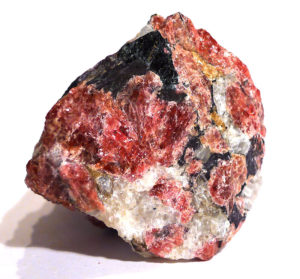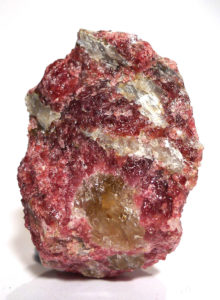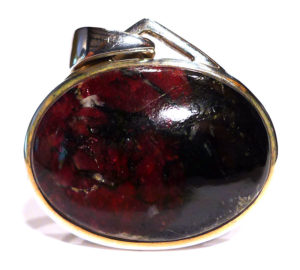Properties:
This chemically complex mineral is all about the heart: it clears, opens and stimulates the heart chakra, and brings a profound sense if joy, exhilaration, and a child-like delight in life. It banishes depression, while it encourages physical energy and motivation – we almost believe we can fly. Eudialyte helps us connect with our sexuality and improves libido, when worn or held with this intention. There is generally an inclusion of white agrellite in its matrix, which brings further cleansing, and alignment throughout the chakra system. Many examples also contain black inclusion, which is ferri-katophorite or aegerine (both minerals occur with eudialyte), or in some cases pegmatite. This helps to consolidate the cleansing process, adds an element of grounding and protection, and tempers the euphoria eudialyte can produce, making it easier to work with. All these minerals together in matrix create an environment in which to work on many levels or dimensions in relative safety. Spiritually, eudialyte reminds us to love humanity and be compassionate to others, no matter how challenging we may find them, and strengthens our love of whatever we hold sacred or divine. Physically, it fortifies the skeletal system and aids bone healing. It can be helpful in the treatment of diseases of the heart (as in the organ), but use with care, as it can be very stimulating and may increase heart rate).
Special Handling:
Eudialyte is brittle and has perfect cleavage, and although relatively hard, rough pieces are prone to crumble slightly at the surface, and even polished pieces will break when knocked.
Attributes:
- Chemical Formula: Na16Ca6Fe3Zr3(Si3O9)2(Si9O27)2(OH,Cl)4
- Group: Silicates – cyclosilicates
- Crystal System: Trigonal/hexagonal
- Hardness: 5-6
- Birthstone: No known astrological alignment
- Chakra: Heart,/li>
- Element: Water
Mineralogy:
Eudialyte is a chemically complex mineral that contains sodium, calcium, iron, and zirconium, and occurs in Nepheline syenites and alkalic granites. Although widely occurring, it is relatively rare. Transparent to translucent red to reddish brown eudialyte can occur as crystals or masses. Well-formed crystals are very rare, but faceted stones are very popular. Small bright red crystals come from Mt Saint Hilaire, Quebec, Canada. Massive eudialyte is made into cabochons and spheres. This material is found in Kola Peninsula, Russia as well as Quebec.
History and Tradition:
Discovered in Greenland in 1819, and named from the Greek for “readily decomposable,” in allusion to its easy solubility in acids. Because of its relatively recent discovery, there are no traditions associated with this mineral



